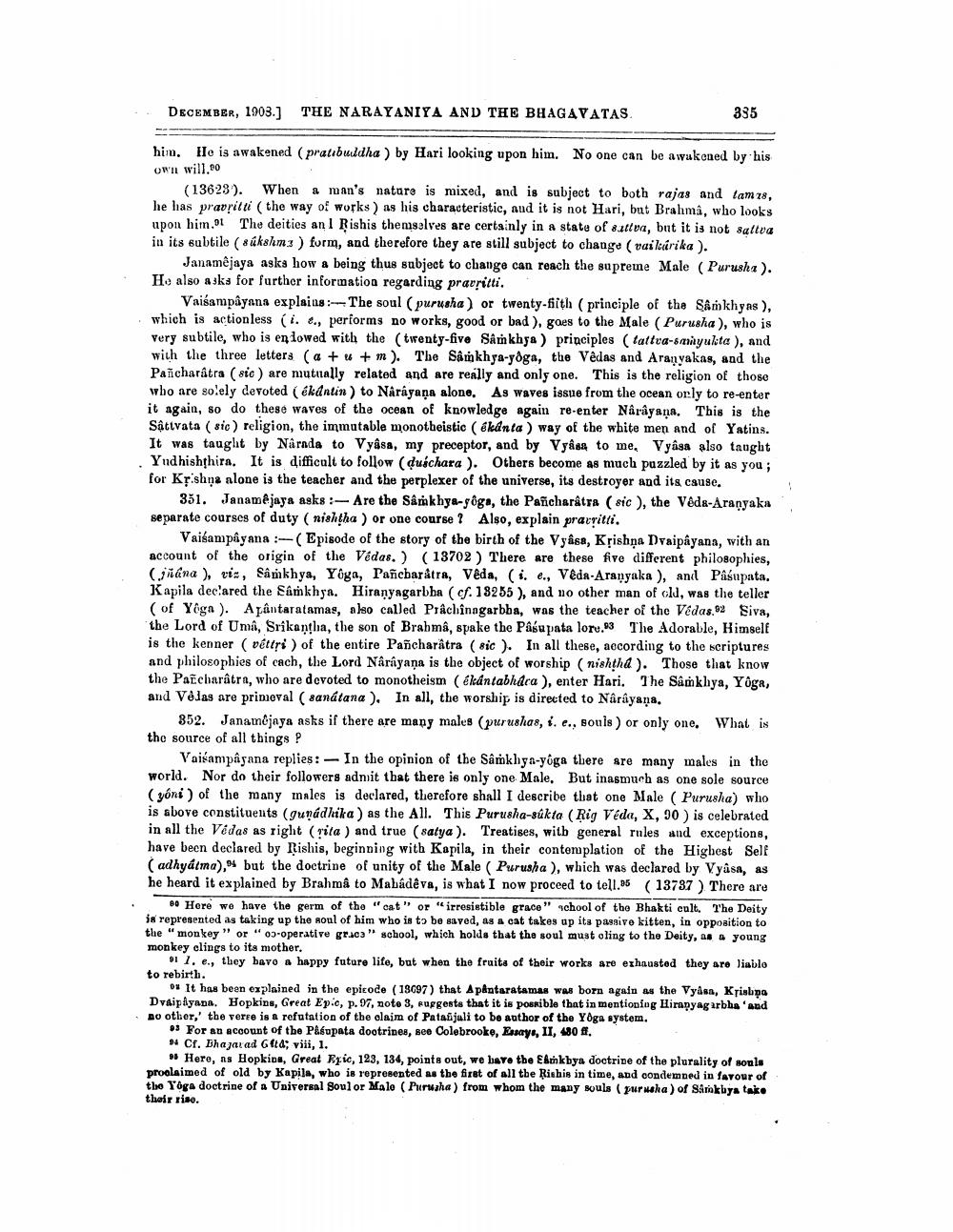________________
DECEMBER, 1903.) THE NARAYANIYA AND THE BHAGAVATAS
335
him. He is awakened (pratbuldha ) by Hari looking upon him. No one can be awakened by his own will.60
(13629). When a man's nature is mixed, and is subject to both rajas and tam 18, he has pravritti (the way of works as his characteristic, and it is not Hari, but Brahma, who looks upon him. The deities an 1 Rishis themselves are certainly in a state of stva, but it is not saltva in its subtile (såkshm3 ) form, and therefore they are still subject to change (vailarika ).
Janamêjaya asks how a being thus subject to change can reach the supreme Male (Purusha ). He also asks for further information regarding pravritti.
Vaisampayana explains :--The soul (purusha) or twenty-fith (principle of the Sámkhyas ), which is actionless (i. &., performs no works, good or bad ), goes to the Male (Purusha ), who is Very subtile, who is endowed with the twenty-five Sårkhya ) principles (tattra-smyukta ), and with the three letters ( a + 4 + m). The Sámkhya-yoga, the Vedas and Aranyakas, and the Paicharâtra (sic) are mutually related and are really and only one. This is the religion of those who are solely devoted (éküntin) to Narayana alone. As waves issue from the ocean orly to re-enter it again, so do these waves of the ocean of knowledge again re-enter Narayana. This is the Sativata (sic) religion, the immutable monotheistic ( ékánta ) way of the white men and of Yatins. It was taught by Nâ rada to Vyâsa, my preceptor, and by Vyasa to me. Vyasa also taught Yudhishthira. It is difficult to follow (duschara ). Others become as much pazzled by it as you ; for Kțishna alone is the teacher and the perplexer of the universe, its destroyer and its cause.
351. Janamêjaya asks :- Are the Samkhya-gôga, the Pancharatra (sic), the Vods-Aranyaka separate courses of duty (nishtha ) or one course ? Also, explain pravritti.
Vaisampayana :-(Episode of the story of the birth of the Vyasa, Krishna Dvaipayana, with an account of the origin of the Vedas.) (13702 ) There are these five different philosophies, (jana ), vis, Sankhya, Yoga, Pañcbarátra, Veda, (i. e., Veda-Aranyaka), and Pasupata. Kapila declared the Eamkhya. Hiranyagarbha (cf. 18255 ), and no other man of old, was the teller (of Yoga). Ajantaratamas, also called Prâchînagarbha, was the teacher of the Vedas.92 Siva, the Lord of Uma, Srikantha, the son of Brahma, spake the Pasupata loru.93 The Adorable, Himself is the kenner (véttri ) of the entire Pancharâtra (sic). In all these, according to the scriptures and philosophies of cach, the Lord Narayana is the object of worship (nishtha ). Those that know the Paccharâtra, who are devoted to monotheism (ékántabhdca ), enter Hari. The Samkhya, Yoga, and Vélas are primoval ( sanatana ). In all, the worship, is directed to Narayana.
352. Janamojaya asks if there are many males (purushas, i. e., souls) or only one. What is the source of all things ?
Vaisampayana replies: - In the opinion of the Samkhya-yoga there are many males in the world. Nor do their followers admit that there is only one Male. But inasmuch as one sole source ( zóni) of the many males is declared, therefore shall I describe that one Male (Purusha) who is above constituents (gunádhika ) as the All. This Purusha-súkta (Rig Veda, X, 90 ) is celebrated in all the Vedas as right (rita ) and true (satya). Treatises, with general rules and exceptions, have been declared by Rishis, beginning with Kapila, in their contemplation of the Highest Self (adhyatma).94 but the doctrine of unity of the Male ( Purusha ), which was declared by Vyasa, as he heard it explained by Brahmâ to Mabadêva, is what I now proceed to tell.95 ( 13737) There are
Here we have the germ of the "cat" or "irresistible grace" school of the Bhakti cult. The Deity is represented as taking up the soul of him who is to be saved, as a cat takes up its passive kitten, in opposition to the "monkey" or " 05-operative grico" school, which holds that the soul must oling to the Deity, 48 young monkey elings to its mother.
I 1. e., they havo a happy future life, but when the fruits of their works are exhausted they are liablo to rebirth.
* It has been explained in the epicode (18097) that Apåntaratamas was born again as the Vysa, Kyislpa Dvaipiyana. Hopkins, Great Epio, p. 97, note 3, ruggests that it is possible that in mentioning Hirapyagarbha 'aud Bo other,' the verre is a refutation of the claim of Patanjali to be author of the Yöga system,
• For an account of the Pleupata dootrines, sea Colebrooke, Essays, II, 480 ff. 94 Cf. Bhajavad Gita; viii, 1.
# Hero, ns Hopkins, Great Exic, 123, 134, points out, we have the Edunkbya doctrine of the plurality of souls proclaimed of old by Kapila, who is represented as the first of all the Rishis in time, and condemned in favour of the Yoga doctrine of a Universal Soul or Malo (Purusha) from whom the many souls (purusha) of Sarokby take their rise.




